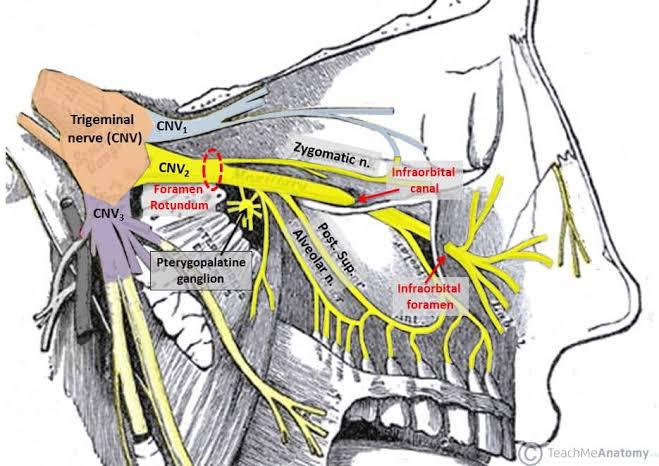What is The Pterygopalatine Ganglion?
The pterygopalatine ganglion, also known as the sphenopalatine ganglion, is a small cluster of nerve cells (ganglion) located in the pterygopalatine fossa, which is a space in the skull behind the maxilla (upper jaw) and below the sphenoid bone. This ganglion is part of the autonomic nervous system, which regulates involuntary bodily functions such as digestion, heart rate, and respiratory rate.
The pterygopalatine ganglion is involved in the parasympathetic innervation of various structures in the head and neck, including the lacrimal gland (which produces tears), the glands of the nasal mucosa, and the blood vessels in the nasal cavity. Activation of the parasympathetic fibers from this ganglion can lead to increased tear production and nasal gland secretion.
Clinically, the pterygopalatine ganglion is sometimes targeted for therapeutic interventions in the treatment of certain conditions, such as cluster headaches and trigeminal neuralgia. Various techniques, including nerve blocks, may be employed to modulate the activity of this ganglion in an attempt to alleviate pain or other symptoms associated with these conditions.
What is The Role of The Pterygopalatine Ganglion in Headache Disorders?
The pterygopalatine ganglion (PPG) plays a role in certain headache disorders, particularly in the context of cluster headaches and migraines. The exact mechanisms are complex and not fully understood, but researchers and clinicians believe that the involvement of PPG in headache disorders may be related to its role in regulating blood flow, sensory processing, and pain perception in the head and face.
1. Cluster Headaches:
The PPG is implicated in cluster headaches, a type of primary headache characterized by severe, unilateral pain typically around the eye. During a cluster headache attack, there is often activation of the trigeminal-autonomic reflex, which involves the trigeminal nerve (responsible for facial sensation) and autonomic nerves. The PPG is part of this reflex loop. Stimulation of the PPG can lead to vasodilation (widening of blood vessels) and release of neuropeptides, contributing to the intense pain experienced during a cluster headache.
1. Migraines:
While the exact role of PPG in migraines is still not fully understood, it is thought to be involved in the modulation of pain and vascular changes associated with migraines. The trigeminal-autonomic reflex may also play a role in migraines, and the PPG is part of this reflex loop. Activation of the PPG can lead to changes in blood flow and release of vasoactive substances, potentially contributing to the throbbing pain characteristic of migraines.
1. Therapeutic Interventions:
Given its involvement in certain headache disorders, the PPG has been a target for therapeutic interventions. Nerve blocks or other procedures that modulate the activity of the PPG may be used in an attempt to relieve or reduce the frequency of cluster headaches or migraines. These interventions may include the administration of local anesthetics or other agents to the PPG region to block or modulate nerve activity.
What is a Pterygopalatine Ganglion Block?
A pterygopalatine ganglion (PPG) block, also known as a sphenopalatine ganglion block, is a medical procedure used to temporarily disrupt or modulate the activity of the pterygopalatine ganglion. This procedure is often employed as a therapeutic intervention for certain types of headaches, particularly cluster headaches, and migraines, where the pterygopalatine ganglion is believed to play a role in the initiation or propagation of pain.
What Can PPG Blocks Treat?
- Hay fever
- Sinusitis
- Vasomotor rhinitis
- Cluster headache
- Migraine
- Dry eyes
- Eustachian tube dysfunction
- Trigeminal neuralgia
- Herpes zoster
- Paroxysmal hemicrania
- Cancer of the head or neck
- Facial pain that is atypical
- Complex regional pain syndrome (CRPS)
- Temporomandibular disorder
- Nasal contact point headache
How is the PPG block/situation performed?
There are two popular ways to perform PPG blocks/stimulation. In the first one, doctors indirectly access the PPG from the nose. The energy of laser or local aesthetics needs to cross the nasal membrane to reach the nerve. This method is popular because it can be performed with minimal training. In the other method, the PPG block is performed in the operating theatre with sedation. The local anesthetic agent is delivered accurately. However, this method requires day procedure hospital admission and sedation, which involves more risks.
How do we do it differently?
We use needles to stimulate/block the PPG directly without sedation. Patients can tolerate the procedure well without the aftercare of sedation. The relief of symptoms is also quicker.
What are the risks?
The risks of the procedure are typically minimal. They include discomfort during and after the procedure, a numb sensation when swallowing, minor bleeding, and light-headedness. These side effects typically resolve within minutes to a few hours. There is a very small risk of seizures, infection, and allergic reactions.

